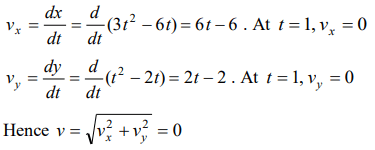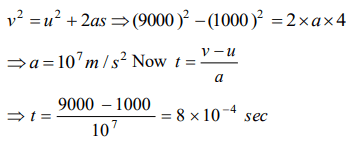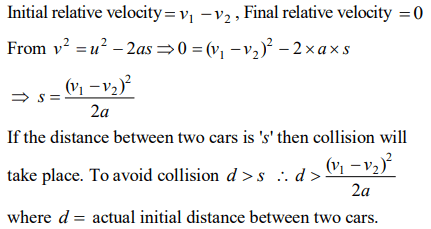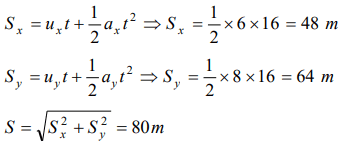1. The position of a particle moving in the xy-plane at any time t is given by \[X=\left(3t^{2}-6t\right)\] metres, \[Y=\left(t^{2}-2t\right)\] metres. Select the correct statement
about the moving particle from the following
a) The acceleration of the particle is zero at \[t=0\] second
b) The velocity of the particle is zero at \[t=0\] second
c) The velocity of the particle is zero at \[t=1\] second
d) The velocity and acceleration of the particle are never zero
Explanation:

2. If body having initial velocity zero is moving with uniform acceleration \[8 m\diagup sec^{2}\] the distance travelled by it in fifth second will be
a) 36 metres
b) 40 metres
c) 100 metres
d) Zero
Explanation:

3. An alpha particle enters a hollow tube of 4 m length with an initial speed of 1 km/s. It is accelerated in the tube and comes out of it with a
speed of 9 km/s. The time for which it remains inside the tube is
a) \[8\times 10^{-3}s\]
b) \[80\times 10^{-3}s\]
c) \[800\times 10^{-3}s\]
d) \[8\times 10^{-4}s\]
Explanation:

4. Two cars A and B are travelling in the same direction with velocities \[V_{1}\] and \[V_{2}\left(V_{1}>V_{2}\right)\] . When the car A is at a distance d ahead of the car B ,
the driver of the car A applied the brake producing a uniform retardation a . There will be no collision when
a) \[d<\frac{\left(V_{1}-V_{2}\right)^{2}}{2a}\]
b) \[d<\frac{V_{1}^{2}-V_{2}^{2}}{2a}\]
c) \[d>\frac{\left(V_{1}-V_{2}\right)^{2}}{2a}\]
d) \[d>\frac{V_{1}^{2}-V_{2}^{2}}{2a}\]
Explanation:

5. A body of mass 10 kg is moving with a constant velocity of 10 m/s. When a constant force acts for 4 seconds on it, it moves with a velocity 2 m/sec
in the opposite direction. The acceleration produced in it is
a) \[3m\diagup sec^{2}\]
b) \[-3m\diagup sec^{2}\]
c) \[0.3m\diagup sec^{2}\]
d) \[-0.3m\diagup sec^{2}\]
Explanation:

6. A body starts from rest from the origin with an acceleration of \[6m\diagup sec^{2}\] along the x-axis and \[8m\diagup sec^{2}\] along the y-axis. Its distance from the
origin after 4 seconds will be
a) 56 m
b) 64 m
c) 80 m
d) 128 m
Explanation:

7. A car moving with a velocity of 10 m/s can be stopped by the application of a constant force F in a distance of 20 m. If the velocity of the car is 30 m/s, it can be stopped by this force in
a) \[\frac{20}{3}m\]
b) 20 m
c) 60 m
d) 180 m
Explanation:

8. The displacement of a particle is given by \[y=a+bt+ct^{2}-dt^{4}\] . The initial velocity and acceleration are respectively
a) \[b,-4d\]
b) \[-b,2c\]
c) \[b,2c\]
d) \[2c,-4d\]
Explanation:

9. A car moving with a speed of 40 km/h can be stopped by applying brakes after atleast 2 m. If the same car is moving with a speed of 80 km/h, what is the minimum stopping distance
a) 8 m
b) 2 m
c) 4 m
d) 6 m
Explanation:

10. An elevator car, whose floor to ceiling distance is equal to 2.7 m, starts ascending with constant acceleration of \[1.2 m s^{-2}\] . 2 sec after the start, a
bolt begins fallings from the ceiling of the car. The free fall time of the bolt is
a) \[\sqrt{0.54 s}\]
b) \[\sqrt{6 s}\]
c) 0.7 s
d) 1 s
Explanation:
